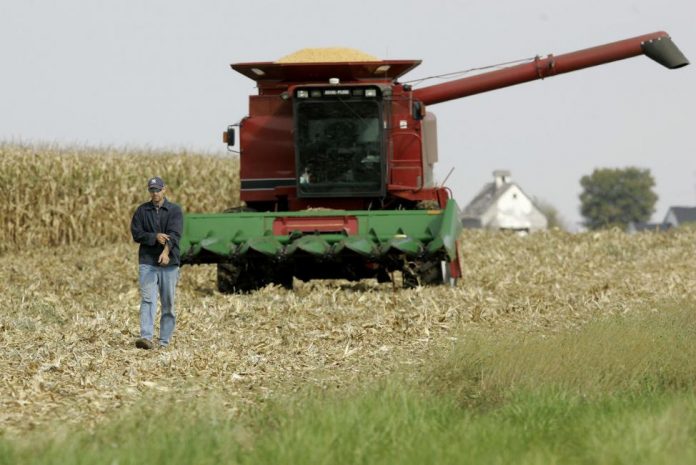
EVANSVILLE, Ind., Jan 1 (UPI) — For America’s farmers, 2019 was a year of depressed prices, vanishing trade and disastrous weather. But, as the year drew to a close, some 11th-hour victories made them cautiously optimistic for a better 2020.
“It seems like, maybe, there’s a light at the end of the tunnel,” said Curt Mether, an Iowa corn and soybean grower.
That light came in the form of trade deals.
On Dec. 13, the U.S. and China announced they had agreed to a preliminary “Phase 1” deal. President Donald Trump tweeted Tuesday that he will sign the deal Jan. 15. For some farmers, the news signaled an end to the 18-month trade war that has put a major strain on America’s farm economy may be in sight.
Less than a week later, the House of Representatives passed the new United States Mexico Canada trade agreement — after more than a year of negotiating with the White House — that ensures free trade will continue with America’s two leading agricultural buyers.
The Senate is to vote on the deal early this year. It is expected to pass.
“The trade deals are both giving us some hope,” Mether said. “The passage of USMCA, we’re really excited about. We need that. And the China deal, even if it’s phase one, it’s something. We have some hope.”
In a show of goodwill, China doubled its American soybean purchases from October to November as the nations negotiated the deal, which created even more optimism among farmers, said Jim Sutter, the U.S. Soybean Export Council’s chief executive officer.
Industry experts note, though, that the purchases came during a time when there were few soybeans available elsewhere in the world, and that U.S. sales could decline again when the Brazilian crop is harvested.
A return to normal trade with China — which has historically vied with Canada to be America’s top agricultural buyer — could rescue commodity prices and save farms from bankruptcy and closure in 2020.
But farmers are tempering their hope.
Throughout 2019, the Trump administration and China have made several announcements that they were making progress on trade deals that never materialized.
Details of this latest Phase 1 agreement are scant, and many in the farming sector are hesitant to believe they ultimately will benefit.
“We are pretty skeptical that the situation with China can be resolved that easily,” said Jenny Hopkinson, senior government relations representative at the National Farmers Union.
Mether, like many farmers, is planning for the worst.
“We’re selling some corn now,” he said two weeks ago. “Corn prices spiked with all the trade news. So, we’re hedging our bets and selling some now in case we don’t get the trade deals and the price goes down again.”
He added: “We’ve had too many false starts. We’re afraid to be too confident.”
The China trade war began in summer 2018, when the Trump administration levied billions of dollars in tariffs on Chinese goods in response to “unfair trade practices.” China responded with commensurate tariffs of its own, many directed at American farm products.
The year before, China had been America’s second top agricultural buyer, importing nearly $20 billion in food in 2017. By the end of 2018, it had fallen to fifth, buying just $9 billion, according to the U.S. Department of Agriculture. The agency predicted trade would decline further in 2019.
The sudden and dramatic loss of sales has rocked America’s farm economy, driving down prices and discouraging many in the agriculture industry.
“Farmers had a tough year in 2019,” Hopkinson said.
The soybean industry was hit particularly hard. China had been buying roughly one-third of all the beans grown in the United States before the tariffs started and purchases fell dramatically.
As Chinese buyers looked elsewhere for soy, the price for American beans plummeted. Many farmers were left unable to sell their beans, and much of the 2018 crop remains stored in grain bins across the Midwest.
“We really need China as a trading partner,” said Katie Johnson, a spokeswoman for the Iowa Soybean Association. “Nothing replaces China.”
While the distressed soybean industry dominated headlines, they were far from the only commodity to suffer, said Brian Kuehl, the co-executive director of the anti-tariff advocacy group Farmers for Free Trade.
The dairy industry estimates it has lost more than $2 billion to tariffs since the trade war began. Pork producers say they’ve lost untold sales — which might have been historically high given that an African swine fever epidemic in China has decimated that country’s hog population.
Almonds, pecans, apples and cotton growers all took hits. Even tiny industries, like Maine’s wild blueberries, lost substantial exports and money.
“You travel around the country and almost all the commodities are squeezed by the trade war,” Kuehl said. “I don’t think there is a sector of the agricultural economy that’s been unscathed.”
And China was not the only country with which the United States has exchanged tariff hikes, Kuehl said. The Trump administration has levied widespread steel and aluminum tariffs to nations around the world.
“Most countries retaliated against U.S. agricultural products,” Kuehl said. “We haven’t just had a trade war with China, we’ve had a global trade war.”
The international markets began crumbling at a time when the agricultural economy already was weak.
Starting around 2014, nearly all commodity prices hit a cyclical low, said John Newton, the chief economist with the American Farm Bureau Federation. This was not unusual. High and low price cycles are common in the farming world, and they likely would have rebounded by now — but for the trade war, Newton said.
“We’re in our sixth year of depressed farm commodity prices,” said Jenny Hopkinson, senior government relations representative at the National Farmers Union. “Things were already bad out there, and [the trade war] just added another layer to it.”
By the end of 2019, the farm economy was showing signs of serious distress.
Farm bankruptcy filings were up by 24 percent in October over the previous year, according to the American Farm Bureau Federation.
The Federal Reserve Bank of Kansas City, Mo., announced in November that farm incomes were down across the Midwest. Farmers were selling assets and taking out increasingly large loans in response, the Fed said.
And according to the American Bankers Association, 43 percent of farmers who borrowed from its members were not profitable in 2019.
If this trend continues, more farmers will go out of business in 2020, industry experts say. Many will be young farmers who don’t have enough capital or savings to continue operating at a loss.
“We’re in danger of losing an entire generation of farmers,” said Mether, who also is president of the Iowa Corn Growers Association.
But, he quickly added: “If we get a trade deal with China, and they start buying corn and soybeans, and the USMCA gets passed, we might have a good year yet.”






